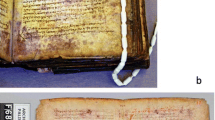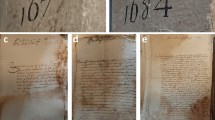Abstract
In 2006, after a visual inspection of the Leonardo da Vinci’s Atlantic Codex by a scholar, active molds were reported to have been present on Codex pages showing areas of staining. In the present paper, molecular methods were used to assess the current microbiological risk to stained pages of the manuscript. Bacterial and fungal communities were sampled by a non-invasive technique employing nitrocellulose membranes. Denaturing gradient gel electrophoresis of 16 S rRNA gene and internal transcribed space regions were carried out to study the structure of the bacterial and fungal communities and band patterns were analyzed by the multivariate technique of principal component analysis. Any relationship between the presence of an active microbial community and staining was excluded. The presence of potential biodeteriogens was evaluated by constructing bacterial and fungal clone libraries, analyzing them by an operational taxonomic unit (OTU) approach. Among the bacteria, some OTUs were associated with species found on floors in clean room while others were identified with human skin contamination. Some fungal OTU representatives were potential biodeteriogens that, under proper thermo-hygrometric conditions, could grow. The retrieval of these potential biodeteriogens and microorganisms related to human skin suggests the need for a continuous and rigorous monitoring of the environmental conditions, and the need to improve handling procedures.





Similar content being viewed by others
References
Bruns TD, White TJ, Taylor JW (1991) Fungal molecular systematic. Annu Rev Ecol Syst 22:525–564
Bundy JG, Paton GI, Campbell CD (2004) Combined microbial community level and single species biosensor responses to monitor recovery of oil polluted soil. Soil Biol Biochem 36:1149–1159
Cappitelli F, Sorlini C (2010) Paper and manuscripts. In: Mitchell R, McNamara C (eds) Cultural heritage microbiology: fundamental studies in conservation science. ASM Press, Washington, pp 45–59
Chen YC, Eisner JD, Kattar MM, Rassoulian-Barrett SL, Lafe K, Bui U, Limaye AP, Cookson BT (2001) Polymorphic internal transcribed spacer region 1 DNA sequences identify medically important yeasts. J Clin Microbiol 39:4042–4051
Clarkson JM, Charnley AK (1996) New insights into the mechanisms of fungal pathogenesis in insects. Trends Microbiol 4:197–203
DeSantis TZ, Hugenholtz P, Larsen N, Rojas M, Brodie EL, Keller K, Huber T, Dalevi D, Hu P, Andersen GL (2006) Greengenes, a chimera-checked 16 S rRNA gene database and workbench compatible with ARB. Appl Environ Microbiol 72:5069–5072
Felsenstein J (1993) PHYLIP (Phylogeny Inference Package) version 3.5c. Distributed by the author. Department of Genetics, University of Washington, Seattle
Gardes M, Bruns TD (1993) ITS primers with enhanced specificity for basidiomycetes—applications to the identification of mycorrhizae and rusts. Mol Ecol 2:113–118
Haakensen M, Dobson CM, Deneer H, Ziola B (2008) Real-time PCR detection of bacteria belonging to the Firmicutes phylum. Int J Food Microbiol 125:236–41
Lovell CR, Decker PV, Bagwell CE, Thompson S, Matsui GY (2008) Analysis of a diverse assemblage of diazotrophic bacteria from Spartina alterniflora using DGGE and clone library screening. J Microbiol Meth 73:160–171
Micali O, Montacutelli R, Tarsitani G (2003) Pathogenic microorganisms and situations of risk to man. In: Mandrioli P, Caneva G, Sabbioni C (eds) Cultural heritage and aerobiology. Kluwer Academic Publisher, Netherlands, pp 31–43
Michaelsen A, Pinar G, Montanari M, Pinzari F (2009) Biodeterioration and restoration of a 16th-century book using a combination of conventional and molecular techniques: a case study. Int Biodeterior Biodegrad 63:161–168
Michaelsen A, Pinzari F, Ripka K, Lubitz W, Pinar G (2006) Application of molecular techniques for identification of fungal communities colonising paper material. Int Biodeterior Biodegrad 58:133–141
Morris CE, Bardin M, Berge O, Frey-Klett P, Fromin N, Girardin H, Guinebretière M-H, Lebaron P, Thiéry JM, Troussellier M (2002) Microbial Biodiversity: approaches to experimental design and hypothesis testing in primary scientific literature from 1975 to 1999. Microbiol Mol Biol Rev 66:592–616
Murray AE, Preston CM, Massana R, Taylor LT, Blakis A, Wu K, Delong EF (1998) Seasonal and spatial variability of bacterial and archaeal assemblages in the coastal waters near Anvers Island, Antarctica. Appl Environ Microbiol 64:2585–2595
Pasquariello G, Laudisa A, Zacchi M, Tarsitani G, Architrave R, Moroni C (2009) Diagnostica e restauro conservativo di documenti fotografici storici: problematiche di indagine e di intervento. In: Lo stato dell’arte 7, Proceedings of VII Congresso Nazionale IGIIC Napoli, Castel Dell’Ovo 8–10 October, Nardini, Firenze, pp 89–96
Pasquariello G, Moroni C, Architrave R, Tarsitani G (2008) Il rischio biologico nelle attività di conservazione e restauro dei beni culturali. In: Lo stato dell’arte 6, Proceedings of VI Congresso Nazionale IGIIC Spoleto, Rocca Albornoziana 2–4 October, Nardini, Firenze, pp 156–165
Pepe O, Sannino L, Palomba S, Anastasio M, Blaiotta G, Villani F, Moschetti G (2010) Heterotrophic microorganisms in deteriorated medieval wall paintings in southern Italian churches. Microbiol Res 165:21–32
Pitzurra L, Bellezza T, Giammarioli M, Giraldi M, Sbaraglia G, Spera G, Bistoni F (1999) Microbial environmental monitoring of the refectory in the monastery of St. Anna in Foligno, Italy. Aerobiologia 15:203–209
Pitzurra M, Savino A, Pasquarella C, Poletti L (1997) A new method to test the microbial contamination of surfaces. Hyg Med 22:77–92
Poletti L, Pasquarella C, Pitzurra M, Savino A (1999) Comparative efficiency of nitrocellulose membranes versus RODAC plates in microbial sampling on surfaces. J Hosp Infect 41:195–201
Rakotonirainy MS, Heude E, Lavedrine B (2007) Isolation and attempts of biomolecular characterization of fungal strains associated to foxing on a 19th century book. J Cult Herit 8(2):126–133
Rasband W (2008) ImageJ 1997–2007. US National Institutes of Health. Bethesda, Maryland, USA
Rinaldi MG (1983) Invasive aspergillosis. Rev Infect Dis 5:1061–1077
Saitou N, Nei M (1987) The neighbor-joining method: a new method for reconstructing phylogenetic trees. Mol Biol Evol 4:406–425
Schloss PD, Westcott SL, Ryabin T, Hall JR, Hartmann M, Hollister EB, Lesniewski RA, Oakley BB, Parks DH, Robinson CJ, Sahl JW, Stres B, Thallinger GG, Van Horn DJ, Weber CF (2009) Introducing mothur: open-source, platform-independent, community-supported software for describing and comparing microbial communities. Appl Environ Microbiol 75:7537–7541
Şimşekly Y, Gucin F, Asan A (1999) Isolation and identification of indoor airborne fungal contaminants of food production facilities and warehouses in Bursa, Turkey. Aerobiologia 15:225–231
Tamura K, Dudley J, Nei M, Kumar S (2007) MEGA4: Molecular Evolutionary Genetics Analysis (MEGA) software version 4.0. Mol Biol Evol 24:1596–1599
Thompson JD, Gibson TJ, Plewniak F, Jeanmougin F, Higgins DG (1997) The CLUSTAL X windows interface: flexible strategies for multiple sequence alignment aided by quality analysis tools. Nucleic Acids Res 25:4876–4882
Varga J, Kocsubé S, Tóth B, Frisvad JC, Perrone G, Susca A, Meijer M, Samson RA (2007) Aspergillus brasiliensis sp. nov., a biseriate black Aspergillus species with world-wide distribution. Int J Syst Evol Micr 57:1925–1932
White TJ, Bruns T, Lee S, Taylor J (1990) Amplification and direct sequencing of fungal ribosomal RNA genes for phylogenetics. In: Innis MA, Gelfand DH, Sninsky JJ, White TJ (eds) PCR protocols. Academic, San Diego, pp 315–322
Zhang T, Fang HHP (2000) Digitization of DGGE (denaturing gradient gel electrophoresis) profile and cluster analysis of microbial communities. Biotechnol Lett 22:399–405
Zotti M, Ferroni A, Calvini P (2008) Microfungal biodeterioration of historic paper: preliminary FTIR and microbiological analyses. Int Biodeterior Biodegrad 62:186–194
Acknowledgments
The authors wish to thank the Veneranda Biblioteca Ambrosiana, in particular Don F. Braschi, for providing access to the Atlantic Codex and for making the data available, Prof. G. Tarsitani, Università Sapienza, Rome, for coordinating the microbiological research on the Codex, and Dr. G. Pasquariello, Istituto Nazionale per la Grafica, Rome, for providing an invaluable insight into paper conservation.
Author information
Authors and Affiliations
Corresponding author
Rights and permissions
About this article
Cite this article
Principi, P., Villa, F., Sorlini, C. et al. Molecular Studies of Microbial Community Structure on Stained Pages of Leonardo da Vinci’s Atlantic Codex. Microb Ecol 61, 214–222 (2011). https://doi.org/10.1007/s00248-010-9741-3
Received:
Accepted:
Published:
Issue Date:
DOI: https://doi.org/10.1007/s00248-010-9741-3




